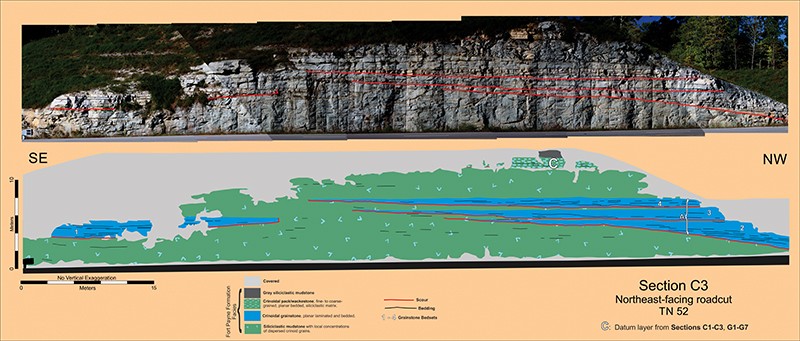Roadcut Sections C1 - C3
Section C1
Roadcut Section C1 displays a prominent crinoid/bryozoan grainstone, multistory channel-fill that has a minimum of 6-meters of erosional relief. The southeast margin is relatively steep and the “flat” floor has up to 2-meters of erosional relief. The basal erosion surface is clearly defined by the contact between the siliciclastic mudstone substrate and the overlying crinoid/bryozoan grainstone; however, where both channel-fill and substrate are of siliciclastic mudstone this surface cannot be detected even upon close examination, see sections C1 Detail 1, 2, and 3.
At least 45% this channel-fill is represented by crinoid/bryozoan grainstone with the remaining 55% being siliciclastic mudstone with dispersed crinoid clasts; Bedset 1 contains the majority of crinoid/bryozoan grainstone. The bedding of Bedset 1 is primarily concordant with the basal erosion surface and thus indicates that deposition was accomplished primarily through simultaneous, vertical accretion over the entire extent of this grainstone body. An erosion surface forms the lower boundary of these bedset; it is readily apparent when two different lithologies are superposed and even when it separates grainstones, however, at the distal northwest extent, where siliciclastic mudstones are superposed it must be inferred, see Section C1 Detail 1.The distal or northwest tip exhibits a “facies-change” into fine-grained crinoid wackestone, see Section C1 Detail 1. This distal wackestone in turn is overlain by siliciclastic mudstone, containing dispersed crinoid and bryozoan clasts, which continues up the front of Bedset 1. The contact at the base of this “draping” siliciclastic mudstone is interpreted to be a “flooding surface” hiatus and not a “facies-change”.
The remainder of the grainstone part of this channel-fill is comprised of off lapping sheets of crinoid/bryozoan grainstone, Bedsets 2-6, that become amalgamated to the southeast. An erosion surface forms the lower boundary of each of these bedsets; it is readily apparent when two different lithologies are superposed and even when it separates grainstones, however, at each distal northwest extent, where siliciclastic mudstones are superposed it must be inferred, see Section C1 Detail 2 and 3. The development of the basal erosion surface(s?) for this multi-story channel-fill may well have been episodic with each successive erosion event re-scouring, and thus deepening and reconfiguring, an initial basal erosion surface.
The distal, or northwest tip of Bedset 2 exhibits a “facies-change” into fine-grained crinoid wackestone by means of a digitate or interfingering relationship, see Section C1 Detail 2. This distal wackestone in turn is overlain by siliciclastic mudstone, containing dispersed crinoid and bryozoan clasts, which continues up the front of Bedset 2. The contact at the base of this “draping” siliciclastic mudstone is interpreted to be a “flooding surface” hiatus and not a “facies-change”. The distal tips of Bedsets 3, 4, and 6 appear to have a “facies-change” directly into siliciclastic mudstone; these grainstones are directly overlain by siliciclastic mudstone the contact with which is interpreted to represent “flooding surfaces”. The distal tip of Bedset 5 has a “facies-change” contact with siliciclastic mudstone by means of a digitate or interfingering contact, see Section C1 Detail 3. Siliciclastic mudstone directly overlies the updip extension of the underlying grainstone in a “flooding surface” configuration.
Thus, all of the crinoids/bryozoan grainstones of Bedsets 1-6 terminate downdip in similar fashions that all suggest simultaneous deposition of grainstone and much finer-grained material followed by the deposition of a siliciclastic mudstone drape that extends high up the underlying grainstone. This indicates that these units resulted from the episodic deposition from sediment gravity flows. These flows probably went along the axis of a fairly wide channel, perhaps analogous to an inverse fluvial point bar in which maximum energy is toward the steeper channel bank rather than out into the deeper parts of the channel.
Bedset 7 is composed of sheet-like deposits of crinoid/bryozoan pack-/wackestones and a culminating crinoid/bryozoan grainstone. These sheets-like deposits thin both to the NW and SE away from a maximum thickness above and to the right of the label “2-6 amalgamated”. This indicates that the deposition of this primarily unconfined unit was influenced by initial surface configuration. Unit C can be traces for up to 2.5 kilometers along these TN52 roadcuts and can be used as a local datum.

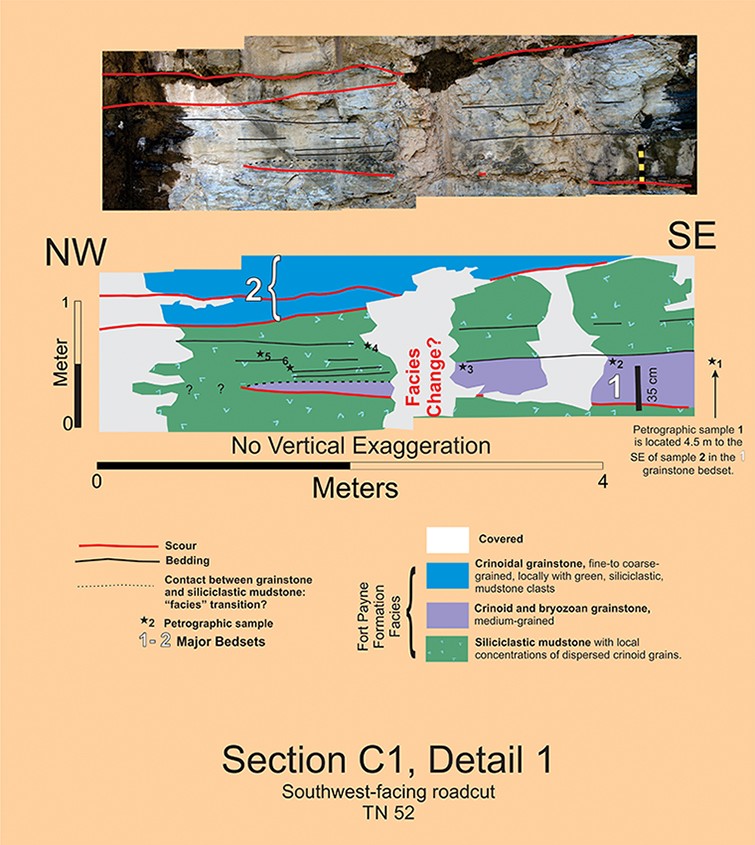
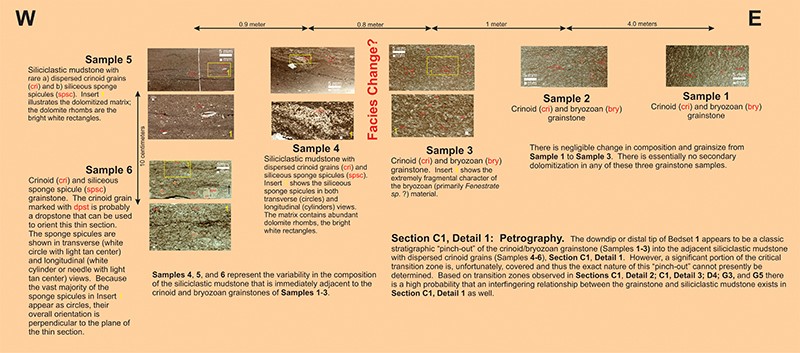
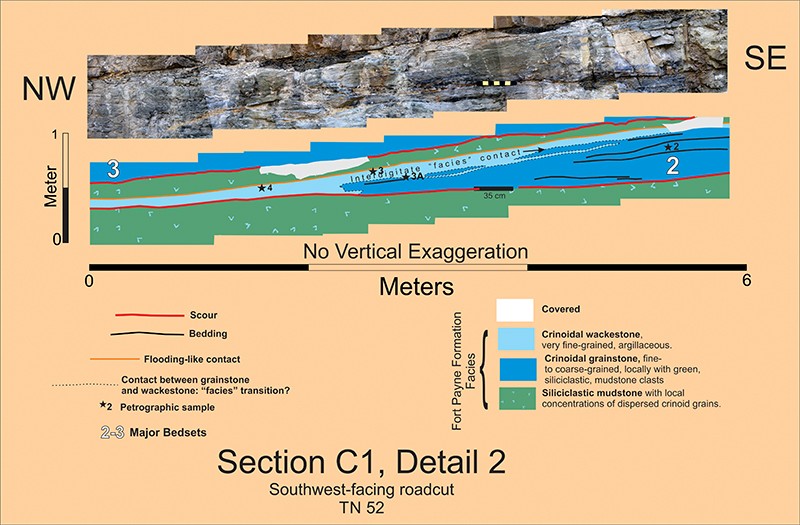
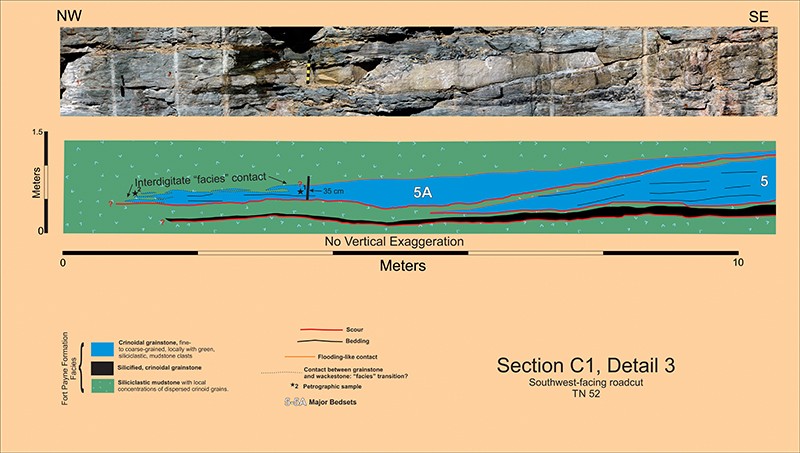
Section C2
Roadcut Section C2 exposes a southwestern continuation of the prominent crinoids/bryozoans grainstone channel-fill of Section C1; Bedsets 1, 2, and 3 are present, however, Bedsets 4, 5, and 6 are absent. There is a minimum of 5-meters of erosional relief indicated for this channel-fill. Each bedset is capped with a siliciclastic mudstone layer. The downdip terminations of these bedsets are not exposed. The bedding in both Bedsets 1 and 2 is concordant with each basal erosion surface which suggests that simultaneous, vertical accretion over the entire respective body was the depositional mechanism. However, deposition of Bedset 3 probably began from the area near the label 3 and prograded both up and down the basal erosion surface, given the up-surface onlap and the down-surface downlap, as well as vertically accreting. These patterns of 1) repetitive lithology couplets and 2) internal stratification indicate episodic erosion and deposition most likely from sediment gravity flows moving along the strikes of these clinoforms, i.e., into or out of the plane of the roadcut. The contact between this grainstone channel-fill and the overlying and adjacent siliciclastic mudstone is erosional with local relief of tens of centimeters over up to several meters. This relationship does not occur in Section C1, which is only 50 or so meters to the northeast, and which attests to the potential variability possible in these channel-fills.
Bedset 7 from Section C1 is present at the top of roadcut Section C2, but in a much reduced thickness. The local datum Unit C is also present, also in a reduced thickness.
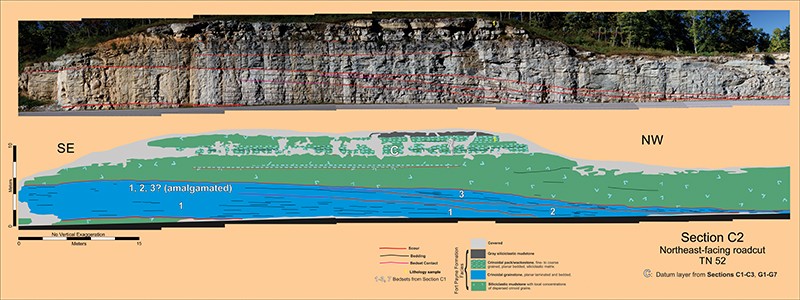
Section C3
Roadcut Section C3 contains four, individual, crinoid/bryozoan grainstone channel-fills, Bedsets 1-4, which are unrelated to any channel-fills in the nearby Sections C1 and C2. In each of these four channel-fills, the planar, horizontal, internal stratification has an onlapping pattern with the respective basal erosion surfaces, an indication of vertical accretion. As with the individual, superposed but not mutually truncating, B and C channel-fills in Section B, it is tempting to assign Bedsets 2-4 into a multi-story channel-fill A. However, careful, detailed examination of the strata patterns confirms that there is no through-going surface to connect these three channel-fills. They are indeed separate, isolated deposits.
Bedset 7 from Sections C1 and C2 is present at the top of roadcut Section C3, but reduced in thickness to only Unit C, the local datum which can be traced for up to 2.5 kilometers along these TN52 roadcuts.
